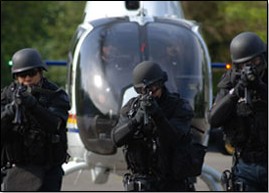Imagine what it’s like to be on the RCMP’s emergency response team. They are trained to respond to threats of CBRN, which stands for chemical, biological, radiological, and nuclear (weapons of mass destruction, as the Americans say), in extremely high-risk situations. For example, they break into clandestine laboratories where crystal meth and other drugs are made using volatile chemicals. Sometimes they use blowtorches to get through metal doors, and if a fire starts, they are on their own because it’s too dangerous for the firefighters to help them.
Now they’re trying out a product called Cold Fire, which “takes the heat out of fire” and is 100 percent biodegradable and non-toxic. It puts out fires differently that traditional dry chemical fire extinguishers by cooling hydrocarbons instead of suppressing oxygen. It’s a trade secret invented by a botanist in Germany in the 1930s, and developed by his son in the 1990s. You can even spray it on a burn.
Video posted on the Cold Fire Canada website
Grant Pearson, president of Cold Fire Canada, is the person who first told me about it. We met at the Western Safety Conference trade show in April and he emailed to tell me the RCMP emergency response team of the Lower Mainland had bought some of the extinguishers.
I phoned Staff Sergeant Ian Daniels of the Lower Mainland RCMP emergency response team to ask how the product will benefit officers’ health and safety at work.
“Typically we’d have some dry chem extinguishers staged close by so if something bad happens you can try to pull your people out and spray them with dry chem extinguisher. The reality is, dry chem is not a healthy thing to get a faceful of,” he said.
“When we go in, typically there may be a bad guy inside with a gun. The fire service is usually there to give us some support for decontamination but they’re not going to be very close until we can say ‘Yeah, there’s no bad guy,’ and so initially we’re sort of on our own. We have medics on our team, but if something bad happens initially, our guys are there by themselves so this Cold Fire is a way we can reduce the risk.”
Grant is the Canadian supplier of Cold Fire and he sees its value to other industries like oil and gas – not to mention kitchen, vehicle, boat, and RVs.
Have you heard about this stuff? It seems like it should be famous already?




Who is grant and where are they located?
Grant is CEO of Cold Fire Canada, based in Vancouver. The website is: http://www.coldfirecanada.com
Has this product been ULC approved?
If it cools hydrocarbons quickly, what would it do if shot into the face of a police officer?
Multi-purpose dry chemical is monamoninium phospate (a fertilizer) and whould be an irritant in the face and is really non toxic.
Still need to know more about Cold Fire to be convinced it’s safer.
Regards,
Doug Drummond
Always important to find out more. Cold Fire is a “UL Classified Wetting Agent – 2N75” according to its website at: http://www.ul.com/global/eng/pages/corporate/aboutul/. Grant told me the product is actually sprayed on people to put out fires and that it’s 100 percent nontoxic and biodegradable.
Pingback: Year-end wrap up for 2011 — Speaking of Safety